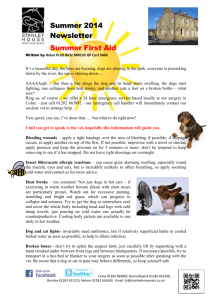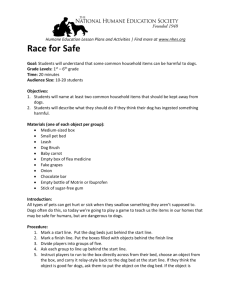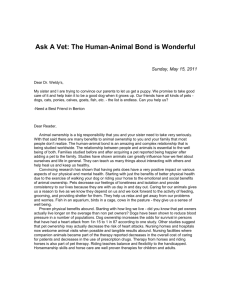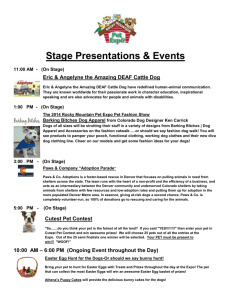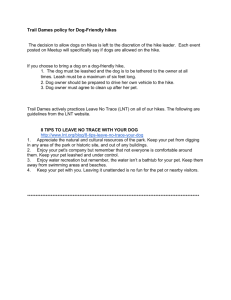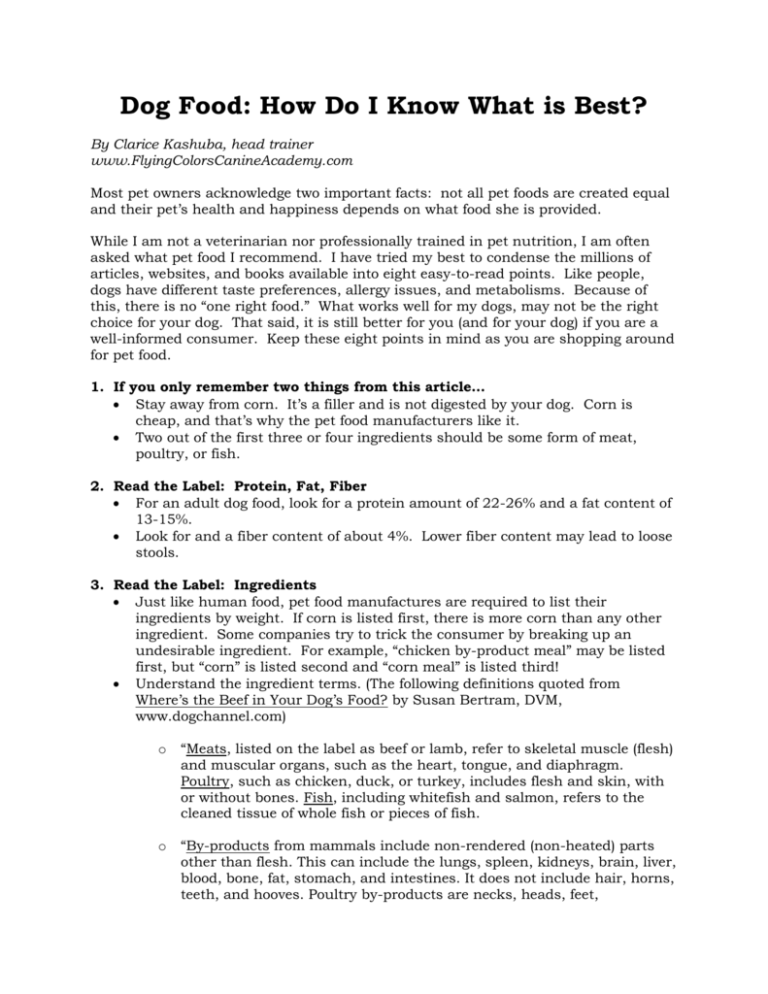
Dog Food: How Do I Know What is Best?
By Clarice Kashuba, head trainer
www.FlyingColorsCanineAcademy.com
Most pet owners acknowledge two important facts: not all pet foods are created equal
and their pet’s health and happiness depends on what food she is provided.
While I am not a veterinarian nor professionally trained in pet nutrition, I am often
asked what pet food I recommend. I have tried my best to condense the millions of
articles, websites, and books available into eight easy-to-read points. Like people,
dogs have different taste preferences, allergy issues, and metabolisms. Because of
this, there is no “one right food.” What works well for my dogs, may not be the right
choice for your dog. That said, it is still better for you (and for your dog) if you are a
well-informed consumer. Keep these eight points in mind as you are shopping around
for pet food.
1. If you only remember two things from this article…
Stay away from corn. It’s a filler and is not digested by your dog. Corn is
cheap, and that’s why the pet food manufacturers like it.
Two out of the first three or four ingredients should be some form of meat,
poultry, or fish.
2. Read the Label: Protein, Fat, Fiber
For an adult dog food, look for a protein amount of 22-26% and a fat content of
13-15%.
Look for and a fiber content of about 4%. Lower fiber content may lead to loose
stools.
3. Read the Label: Ingredients
Just like human food, pet food manufactures are required to list their
ingredients by weight. If corn is listed first, there is more corn than any other
ingredient. Some companies try to trick the consumer by breaking up an
undesirable ingredient. For example, “chicken by-product meal” may be listed
first, but “corn” is listed second and “corn meal” is listed third!
Understand the ingredient terms. (The following definitions quoted from
Where’s the Beef in Your Dog’s Food? by Susan Bertram, DVM,
www.dogchannel.com)
o
“Meats, listed on the label as beef or lamb, refer to skeletal muscle (flesh)
and muscular organs, such as the heart, tongue, and diaphragm.
Poultry, such as chicken, duck, or turkey, includes flesh and skin, with
or without bones. Fish, including whitefish and salmon, refers to the
cleaned tissue of whole fish or pieces of fish.
o
“By-products from mammals include non-rendered (non-heated) parts
other than flesh. This can include the lungs, spleen, kidneys, brain, liver,
blood, bone, fat, stomach, and intestines. It does not include hair, horns,
teeth, and hooves. Poultry by-products are necks, heads, feet,
undeveloped eggs, and intestines, but not feathers (except those that
may be unavoidably included under accepted processing practices).
o
“Meat, fish, poultry, or by-product meal, preceded by a source, such as
lamb meal, refers to the process of rendering (heating) and grinding the
starter ingredient. This removes most of the moisture and fat and
reduces the particle size of the end product. Meat and bone meal
includes rendered mammal tissues and bone, excluding blood, hair, hoof,
horn, hide trimmings, manure, and stomach and rumen contents (with
the same exception as for feathers).
o
“Other protein sources may include dried egg product without shells,
caseinate (milk solids), and whey (the fluid portion of milk).”
While some people are grossed out from the idea of by-products, if my dogs ate
a fresh rabbit they would go first for the innards (including the stomach and
intestines). Therefore, I have no problems feeding my dogs a food with byproducts. Just because I wouldn’t eat it, doesn’t mean my dogs wouldn’t!
Similarly, I have no problem with meal. The only difference between “lamb” and
“lamb meal” is that the meal has had the water cooked out before being
weighed. Therefore, there are actually more nutrients per ounce in “lamb
meal”.
4. Common Allergies
The most common dog allergies are wheat (especially wheat gluten), corn, and
soy.
Allergy symptoms include itchy skin, recurring ear infections, and stomach
upset (excessive gas, diarrhea, vomiting, etc.).
If you have ruled out wheat, corn, and soy as the source of your dog’s
discomfort, try a Sweet Potato and Duck formula. It’s expensive, but very few
dogs are allergic to its ingredients.
Of course, having a veterinarian that you trust is invaluable. Rule out any
serious health problem before just assuming that an allergy is the problem.
5. AAFCO
AAFCO (The Association of American Feed Control Officials) sets guidelines and
definitions for animal feed, including pet foods.
Understand feeding trials. (The following is quoted from Dog Foods,
www.woodhavenlabs.com)
o “Next you're going to look on the label for "AAFCO feeding trials confirm
that Dog Food Name is complete and balanced for adult dogs or all life
stages.” This means the food was actually fed to dogs to determine it
meets the nutritional needs for adult dogs or for all life stages of the dog.
o “Some foods determine the nutritional values in the laboratory. What
this means is that YOUR dog is the guinea pig. The statement regarding
AAFCO might read something like this "Dog Food Name has been shown
to be complete and balanced using testing procedures as outlined by
AAFCO.” See the subtle difference?
o
“If you aren't sure, call the company and ask them directly if their food
was actually fed to dogs during an AAFCO feeding trial.”
6. Marketing Tricks
Beware of perceived value. Just because a food is expensive or sold only at
veterinary offices does not make it the best food for your dog.
Some dog food manufacturers use emotional words such as all natural, healthy,
holistic, fresh vegetables, real meat, and quality. This is just advertising. Please
read the bag and decide for yourself. If the first ingredient is corn, perhaps it’s
time to look into some foods that don’t have multi-million dollar advertising
campaigns but do have better ingredients.
Gimmicks that appeal to people probably don’t matter to your pet. Dogs don’t
care if their kibble is multi-colored or cut into different shapes. I tried a dog
food that had real dehydrated vegetables mixed in with the kibble; one of my
dogs loved it, and the other dog clearly disliked it.
7. Treats and Snacks
Treats should never make up more than 10% of your dog’s daily diet.
Instead of buying treats, which have empty calories, consider buying a different
dog food to feed from the hand (or from a toy) as a treat. My dogs enjoy Duck
and Sweet Potato as a treat. They also like the rolled dog food. It comes like a
tube rolled in plastic, and cuts like salami. It’s expensive dog food, but an
inexpensive dog treat.
Raw carrots are a low calorie treat that many dogs enjoy. Plus, the crunching
action is good for their teeth!
8. Pet Food Recalls
An up to date list of recalls can be found on the FDA’s website. You can simply
Google “pet food recalls.”
You may remember the huge pet food recall that started in March of 2007.
Many pet foods were contaminated with melamine. Yes, people’s pets actually
died. The problem was not only the food – it was how the manufacturers
handled the situation. It took far too long between the first reports of illness
and the warnings to the public. At the time I was feeding ProPlan which is
made by Purina. Some Purina foods were recalled. While ProPlan was not
recalled, I made a personal decision not to continue to support the company.
You could say that they lost my trust. Many of the “big” name brands such as
Eukanuba, Purina, Nutro, and Iams were recalled. You may want to consider
that fact as you search for your pet’s new food.
Copyright 2008 by Clarice Kashuba, All Rights Reserved

